- Life & Culture
Traditional Japanese Clothing and Accessories
Japan is a country of rich culture and history. It’s a place where tradition meets innovation and their clothing reflects this. We’ve all heard of the Kimono but, did you know there are over thirty pieces of traditional Japanese clothing?
Each has a function, history and story. Japanese garments date all the way back to the Jomon Period (300 BC) and have evolved with the country ever since.
These days, many of the garments are ceremonial, but it’s worth brushing up on what to wear for your next trip to Japan.
Traditional Japanese Clothing
Since time immemorial, Japanese traditional clothing has been evolving and changing. From the original kimono to the modern yukata, there is a wide variety of garments that are considered to be Japanese traditional clothing.
While some of these garments are only worn on special occasions, others have become more common in daily life. Let’s explore the rich diversity of traditional Japanese clothing and accessories across the ages.
Kimono
When it comes to traditional Japanese clothing, the Kimono is king. However, despite literally meaning “thing to wear”, there are actually many different styles of Kimono – in excess of ten!
The Kimono was originally accompanied by a long skirt called a Hakama. As time has gone on, it’s become fashionable to wear the Kimono Hakama-less with a small sash, or Obi, to hold it together.
The Kimono is traditionally worn for weddings, tea ceremonies, formal traditional events and funerals. Colours and styles can vary for these events depending on the occasion and age or marital status of the wearer.
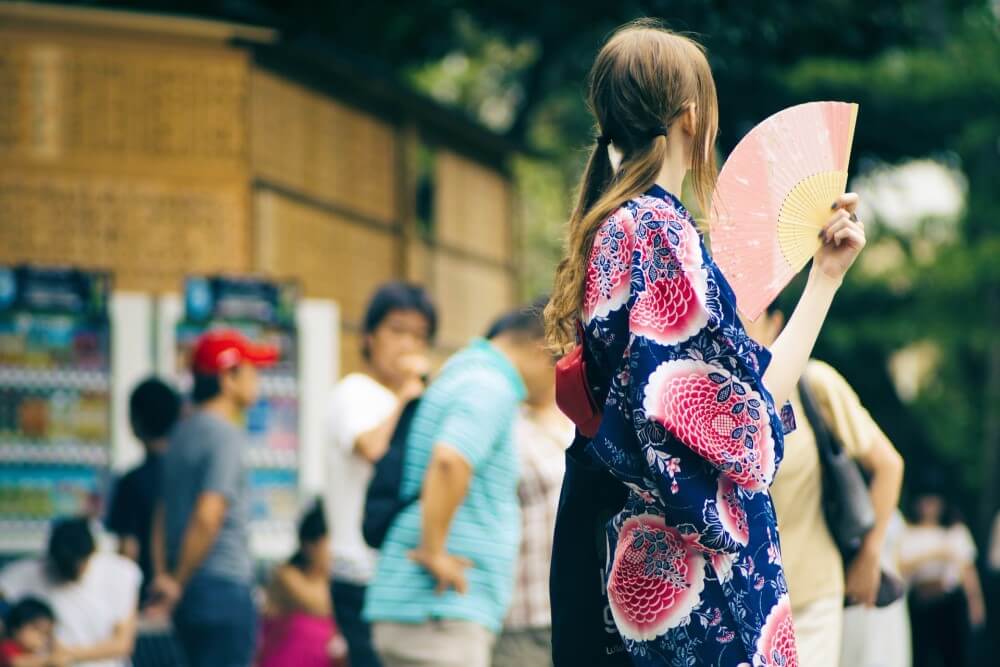
Yukata
For every formal item of clothing, there’s a casual counterpart, and Japanese traditional clothing is no exception.
The Yukata is the casual version of the Kimono. Being made of light, easy-to-wear fabrics, it’s made to be breathable and breezy in the summer months.
Yukata means bathing cloth – which makes sense as it’s traditionally worn without undergarments and again, held together by the Obi sash.
You can expect to see Yukata being worn at summer festivals and in historical cities – like Kyoto. A Yukata is generally much cheaper to buy than a Kimono, so if you are looking for an affordable souvenir to take back, this makes a great option.
Hanten
Switching from summer to winter with a winter coat from the iconic Edo period – between 1603 and 1867. This era produced iconic works of art, such as the Great Wave off Kanagawa.
It also produced the iconic Japanese traditional clothing item, the Hanten. The Hanten is a short, cotton-padded coat with a tailored collar. Its mixture of minimalism and practicality means it still fits into today’s modern wardrobe.
It’s become a coat of the people in Japan, as its cousin, the Haori was restricted to higher social classes. The Hatan has cemented itself as a piece of traditional Japanese clothing for all and when temperatures drop, it could be a coat for you as well.
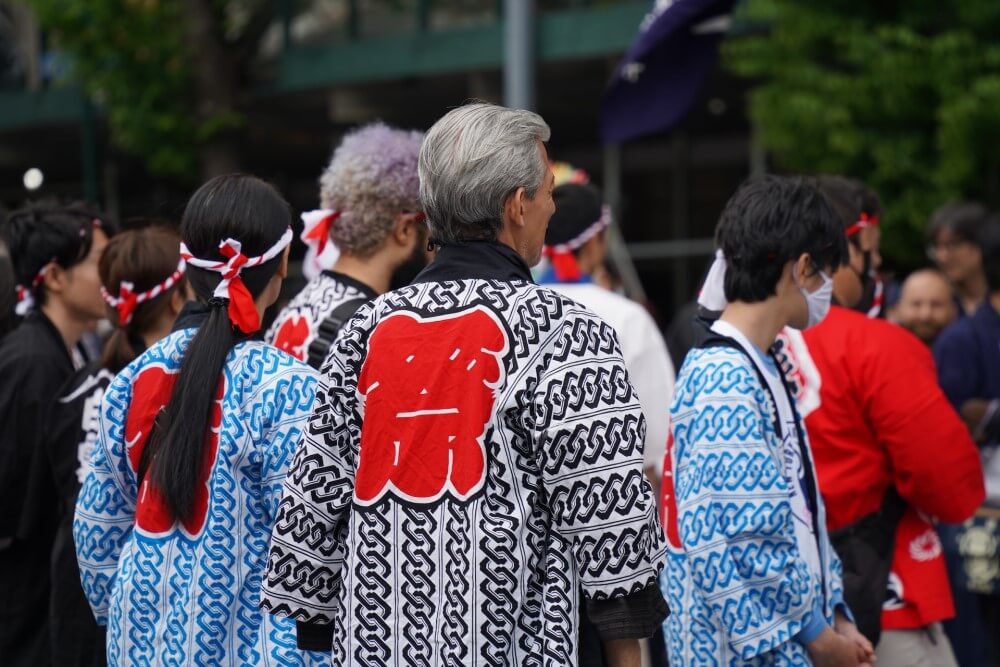
Haori
As mentioned, the Haori was similar to the Hanten and was a loose-fitting jacket with a medium length, mainly worn by higher social classes. It’s one of the most luxurious items in traditional Japanese clothing because of its social exclusivity.
The Haori is normally paired with the Kimono, sitting on top. The origin of respect for the garment stems back to its beginnings, where they were typically worn by warriors during battle, to keep them warm.
Skipping to modern times, Haori is now more commonly worn by a groom during a wedding, at a coming of age ceremony, or other big life events.
Hakama
Interestingly the Hakama comes in two different styles, the undivided andon bakama which is similar to a wide pleated skirt that is traditionally worn over a kimono. Or the divided umanori, which resemble loose-fitting pants (or trousers depending on where you’re from!).
In recent years, when, where and how the Hakama is worn has considerably changed. On both formal and informal occasions, men wear Hakama under their kimonos, while women wear only Hakama at graduation ceremonies and when performing traditional Japanese sports.
Hakama are typically made from a heavy fabric such as wool or cotton, and they are often dyed in dark colours such as black or navy blue.
Michiyuki
A Michiyuki is a traditional Japanese coat worn by women. It is usually made of silk and has a long, flowing design.
The coat is typically worn over a kimono, and the two garments are often tied together with an obi sash. The Michiyuki is a popular choice for special occasions such as weddings and tea ceremonies.
One of the most memorable parts of the Michiuki has got to be its square-shaped neckline. They also share similarities with the aforementioned Haori, with the Michiyuki serving a more practical purpose and being much more simplistic in pattern and design.

Judogi
Moving on from the appearance and feel of a garment, we are now looking at the form and function of the clothing, such as in traditional Japanese sports. The first of which is a Judogi, a traditional Japanese martial arts uniform worn in Judo.
It is made of heavy cotton fabric and consists of a jacket and trousers. The jacket is fastened with a belt, and the pants are held up by a drawstring. The judogi is typically white, but may also be black.
The Judogi was first introduced to Judo in 1882 by Jigoro Kano, the founder of Judo. Kano believed that the uniform would promote cleanliness and respect for one’s opponents.
The Judogi has remained largely unchanged since its inception, though some modern variations include reinforced sleeves and legs to protect against injury. The Judogi plays an important role in Judo matches, as it allows for a grip on the opponent’s clothing, which can be used to control or throw them.
Karategi
The Karategi is another traditional uniform for Japanese sports, this time for karate practitioners. It is a loose-fitting, lightweight garment that is typically made from white linen or cotton.
The Karategi consists of a jacket and pants that are fastened with a belt. The jacket has long sleeves that are typically worn rolled up to the elbows, and the pants have an elastic waistband. The Karategi is typically worn over a pair of black trousers and a white undershirt.
The Karategi is not only practical and comfortable, but it also has symbolic meaning. In Japanese culture, white represents purity and innocence. Wearing a Karategi signifies that the practitioner is committed to the principles of karate: honesty, respect, discipline, and self-control.
Jujutsugi
A Jujutsugi is a uniform worn by those practising the martial art of Jujutsu. Jujutsu, while similar to other martial arts such as karate and judo has distinctive differences.
It is a system of close-quarters combat that utilises strikes, throws, and joint locks. Jujutsu practitioners seek to control and overcome their opponents by using leverage and superior technique.
While similar to the Karategi, the Jujutsugi was designed with slimmer, more formfitting sleeves. This is for the simple fact that it is more difficult to be grabbed with less baggy material, which is one of the aims of Jujitsu.

Aikidogi
Following on from the Judogi, Karategi and Jujutsugi, the Aikidogi are traditional garments worn by practitioners of Aikido.
Similar to the Kimono, the Aikidogi sports longer sleeves and are usually made of white cotton or linen. There are two types of Aikidogi, one that is practically identical to the Judogi with a jacket and trousers, and another that is worn with the previously mentioned Hakama.
Aikidogi are not only practical but also have a symbolic meaning. They represent the purity and simplicity of aikido, as well as the dedication of practitioners to their art. Wearing Aikidogi is a way of showing respect for oneself and others, and is an important part of the Aikido experience.
Kendogi
As you may have noticed, each traditional Japanese uniform for martial arts is named after its practice. The Kendogi is no different and is named after the martial art Kendo.
Kendo is a modern Japanese martial art that is descended from kenjutsu and uses bamboo swords and protective armour – inspired by samurai clothing.
In its simplest form, the Kendogi consists of a Hakama and a jacket, made of cotton woven with thick embroidery to help cushion blows from opponents in kendo. On top of this, you would then suit up in armour, protecting areas such as your head, shoulders, arms, torso and neck.
Samue
Samue is one of the most simplistic traditional Japanese outfits. Rather than being one garment, Samue consists of a matching loose trouser and top set, typically in blue or green.
They are renowned in Japan for being comfy and relaxing and were designed this way intentionally. Originally created by Japanese Zen Buddhist clergy, that they have proven so relaxing, they still wear them to this day.
Because of their practicality and comfort, they have since been adopted by farmers and gardeners, although they are well suited for any job outdoors or labour intensive.
For tourists, Samue make great souvenirs as loungewear. As they are adjustable, they can grow and adjust as we all inevitably do in life, meaning one set can last a lifetime.
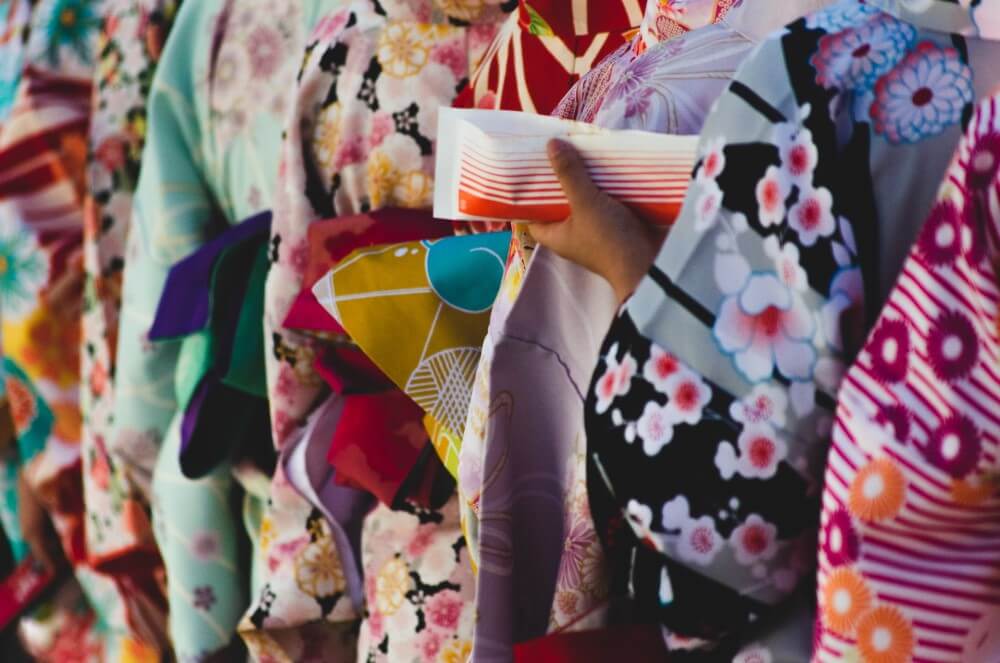
Kimono Robes
During the 12th century Kamakura period of Japan, there was a large bathing culture. Fashion naturally followed this and traditional items like the Kimono evolved into off-shoot variations.
Despite being more like the more informal Yukata, it is a simple bathrobe-style outfit, held together with a belt.
Unlike many traditional Japanese clothing, there are no direct rules on where or how this should be worn – making it very versatile. Kimono Robes can be used for loungewear, sleepwear, outerwear, or as a dress at any time of year.
That said, a common place to see this traditional Japanese costume in action is at Japan’s annual Firework Festivals.
Men’s Nagajuban Robes
Japan throughout its history has built hygiene and bathing into its culture, so why would this be any different for clothes?
Men’s Nagajuban Robes (meaning long underwear) were designed to be worn under the Kimono in order to keep it clean and dry for longer periods of time.
They were commonly constructed from cotton or silk for comfort and were often intricately decorated based on the owner’s preference, making them cool loungewear robes to wear around the home.
It’s essential if you want to get the most accurate traditional male Japanese outfit.
Women’s Nagajuban Robes
Similarly to men’s Nagajuban robes, these are worn underneath the Kimono and are designed to keep them clean and dry for the duration of wearing. These are often made of cotton or silk and despite not being visible, are incredibly cost-effective when investing in a Kimono and protecting that investment.
Kimonos, by the very nature of the material they are made from, can be extremely difficult to keep clean. So this provides a barrier between you and the Kimono, stopping it from absorbing sweat and other bodily fluids which can cause odours.
If dresses aren’t comfortable for you, then there are short sleeve shirts and short versions available which provide the same protection.
Fundoshi
The Fundoshi is one of the standouts on this list, for reasons we’ll get into. They are a type of traditional men’s underwear.
It is made from a long strip of cloth, and it is wrapped around the waist like a loincloth. The Fundoshi has been around for centuries, and it was originally worn by sumo wrestlers.
Today, it is still worn by some wrestlers, but it is also popular among bodybuilders and other athletes. The fundoshi provides support and stability during physical activity, and it can also help to prevent chafing.
If you’re looking to see Fundoshi in action, Japan hosts a yearly self-proclaimed ‘naked festival’ every February in Okayama- specifically sporting a loose-apron-like front edition of the Fundoshi.
We did say it would be a memorable addition to the list…
Tobi Pants
Before you get excited thinking that 90s fashion trends are coming back with balloon pants. There is no correlation between balloon pants and Tobi Pants, despite their similar appearance.
Tobi Pants are traditional Japanese garments and are worn by Japanese workmen as protective wear. Yes, you heard that right – these flowy trousers are worn by construction workers and there is actually a practical reason for doing so.
First of all, because of the loose fit, Tobi Pants are the ideal choice because of their comfort, along with not restricting any movement. The excess of material also acts as a sort of sensor when working on narrow, high-up scaffolding.
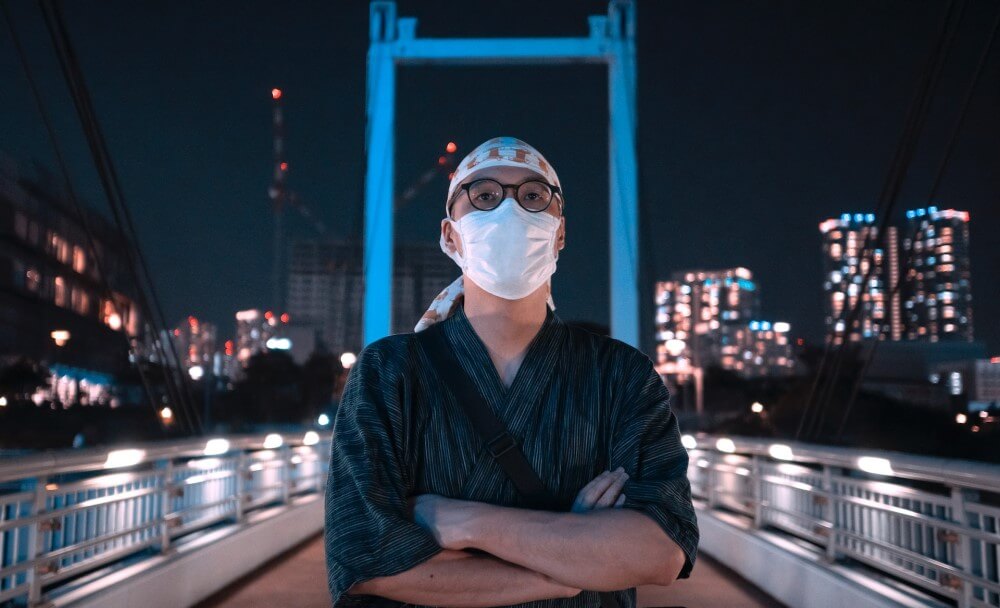
Jinbei
Jinbei are a type of Japanese clothing that is typically worn by men and women during the summer months. They are made from a lightweight fabric and are often brightly coloured. Jinbei can be either short-sleeved or long-sleeved, and sometimes have patterns on them.
Jinbei are usually worn at home, or when participating in leisure activities such as going to the park or the beach. They are comfortable and easy to move in, making them ideal for hot weather. Jinbei are also considered to be stylish and can be dressed up or down depending on the occasion.
Tanzen
Similar to the Hanten, a Tanzen is an item of clothing that is rife in the winter months due to its thicker padding helping to wade off the cold. Interestingly, the Tanzen is a stem of the Kimono, predominantly worn by men during winter.
Befitting to the colder climate, in contrast to the usual Kimono, Tanzen are made from rich cotton rather than the slimmer silk. Since men are the target audience for this traditional Japanese outfit, a Tanzen can commonly be found in darker colours such as navy blue and less pronounced patterns.
Tonbi Coat
Continuing with the trend of layers, a Tonbi Coat is a traditional outer garment worn by men in Japan.
It is made of a thick, durable fabric such as wool or cashmere and typically has a hood. Tonbi coats are usually dark in colour, and are often worn in the winter months to protect against the cold weather.
And if you’d spotted a similarity between that of a Tonbi Coat and the attire of Sherlock Holmes, you’d be correct. The design of the Tonbi Coat was initially inspired by that of the Victorian Inverness capes.
Happi
A Happi can typically mean one thing, they’re off to a festival! A Happi is a light, casual jacket made of thin cotton material and has wide sleeves. Due to this, they are comfortable and easy to move in, making them ideal for festive occasions.
The front of the Happi is typically decorated with the symbol of the event or celebration. Originally worn by house servants with the family house crest, it is now used as a way to identify members of a community during matsuri, a Japanese festival.
Gakuran
A Gakuran is a form of Western-style military uniform and was introduced to Japan during the Meiji period. Originally intended for wear by students at secondary schools and universities.
However, it has become increasingly popular as formalwear for men in recent years and is often seen worn by business people and government officials. The Gakuran is also worn by members of the Japanese Self-Defense Forces, as well as police officers and firefighters.
The Gakuran consists of a black jacket and trousers, with a stand-up collar and button placket. The buttons on a Gakuran are usually silver or brass, and there are typically four to six buttons on the front of the jacket. The trousers are wide-legged and fit snugly around the waist.
Similarly, there is a female version of the Gakuran which resonates with a sailor-style uniform. Comprising a navy blue skirt and white shirt – not to mention a coloured neckerchief to match.
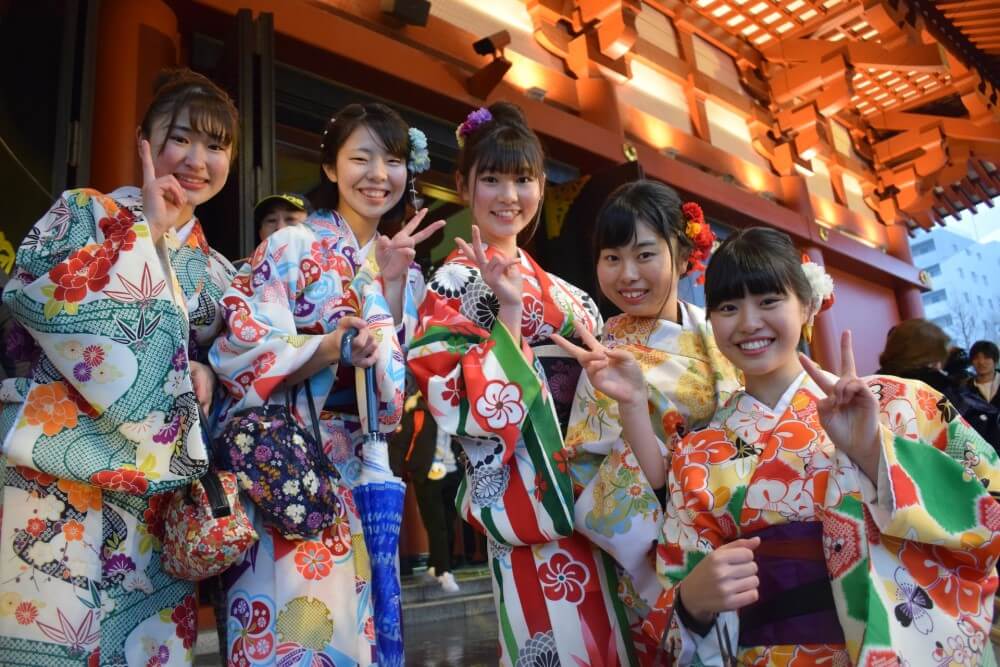
Obi
The Obi is the sash that keeps the Kimono together. It’s often grouped as part of the Kimono for this reason, but the Obi does have some standout features worthy of making it a piece of traditional Japanese clothing in its own right.
Just like a tie with a suit, the Obi can be styled as simply or flamboyantly as the wearer likes. It’s a great example of where Japanese style and practicality come together.
Doubling as a canvas for great artists, Obis make great souvenirs as you can find one that matches your style.
Traditional Japanese Accessories
From functional belts to socks and sandals, complete your traditional Japanese outfit with the right accessories. Below are the most popular traditional Japanese accessories to compliment your long-established garment.
Obijime
One of the key traditional Japanese accessories to compliment your Obi, the Obijime is a braided cord that attaches to the Obi and the Kimono, holding the Obi in place. The Obi is a subtle addition to the entire Kimono look but to avoid any embarrassing Obi slips, it serves a very important function.
Traditionally, they are given by a lover and are made of silk but it’s much more common to buy your own these days. To match the creative variety of the Obi, an Objime comes in many shapes – including flat, round and oval. You can also get them in a variety of sizes, colours and fabrics.
With so many different variations on parts of the Kimono, wearers get to make their own unique version of the outfit that reflects their individuality and personality. Your Kimono can really be your Kimono.
Obidome
Diving even deeper into Kimono accessories, for a truly authentic representation of traditional Japanese outfits, every Obijime should be accompanied by an Obidome.
An Obidome is an accessory to the Obijime akin to a small pendant or brooch. What this looks like exactly is left to the imagination of the wearer. It can be any shape and any material. Simpler, more traditional Obidomes have been constructed from wood or clay. Traditionally, those from wealth constructed them with luxury materials such as diamond, pearl and ivory.
Common Obidome designs for women would be flower-based. This is a popular design with Japanese ladies as it represents hope and virtue.
Obiage
To complete the Obi trilogy, Kimono’s will need an Obiage. Think of a silk scarf, but worn around the waist, wrapped around the obimakura to provide a pop of colour but also, some much-needed comfort.
It’s designed to frame the Obi, making it look more aesthetically pleasing. The Obiage can also be paired with the Yukata.
You can pick any colour you like for the Obiage, but it’s best to get one that compliments your Kimono as it is a visible layer. They are typically constructed of silk, polyester or cotton.
When choosing your Obiage, take the season into account as they may have seasonal design or weave that best suits an occasion.
Kanzashi
A Kanzashi is a type of hairpin that was popularized in Japan during the Edo period. These ornamental hairpins were usually made from metal or tortoiseshell and were often decorated with jewels and other colourful embellishments.
Kanzashi were worn by both men and women as a way to decorate their hairstyles. Today, Kanzashi are still worn by some Japanese people as a way to add a touch of traditional elegance to their appearance.
Hachimaki
A Hachimaki is a traditional Japanese headband that is often worn during physical activities such as festivals, sports, and other strenuous tasks.
The word ‘hachimaki’ actually means “headband” in Japanese, and they are typically red in colour with white writing on them, or black and white. The writing usually has motivational phrases such as “ganbare” (do your best) or “determined spirit”.
Hachimaki are believed to have originated from samurai warriors who would wear them during battle to show their courage and strength. Nowadays, they are still worn by many people during sporting events or when undertaking difficult tasks as a way to boost morale and motivation.
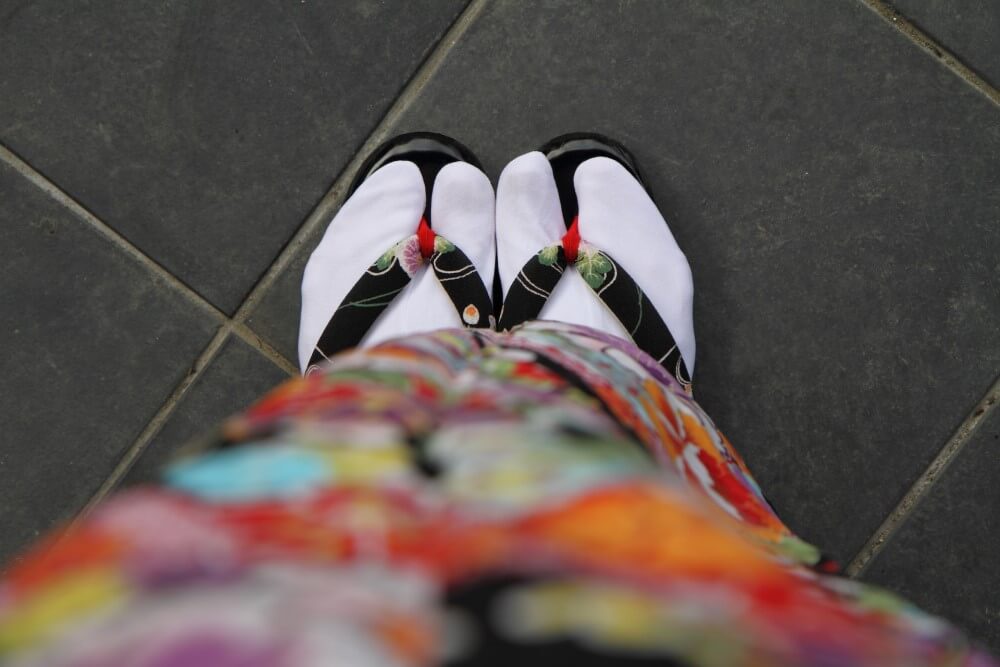
Tabi
From the top of your head to the tip of your toes. Thought to have begun in the Heian period, a Tabi is a traditional Japanese sock with a separation between the big toe and other toes. Tabi are often worn with zori, geta, and other traditional thonged footwear.
Tabi are typically made from cotton or silk and come in a variety of colours, although white is the most common. They are usually ankle-high or slightly longer, but short Tabi that end mid-calf are also available.
The most formal type of Tabi is made of white silk and has a gold embroidered butterfly on the side; these are typically only worn by maiko.
Jika-tabi
A type of Tabi, the Jika-tabi is a type of traditional Japanese footwear that is characterised by its split-toe design.
In contrast to Tabi being worn indoors, Jika-tabi is accustomed to the outdoors, serving the needs of labour workers such as construction workers, farmers and more.
This type of footwear was originally designed for farmers and workers who needed a shoe that would be comfortable and durable enough for long days spent working in the fields.
Geta
Following the trend of footwear, Geta are a type of footwear worn by both men and women in Japan. It is typically made from wood and has a raised platform sole that helps to keep the foot elevated above the ground.
Geta are often worn with a Yukata and other summer attire. In fact, there are numerous iterations of the Geta: the standard two-tooth design (Koma-geta), Senryo-geta with a sloped front tooth. Not to mention the Ukon-gata which are much like wearing regular sandals.
Zori
A zori is a type of Japanese sandal made from rice straw and cloth. They are typically worn with Yukata, but can also be worn with other traditional Japanese clothing.
Zori are usually made with a thong toe strap and heel strap, and often have decorative elements such as beads or shells. They are usually accompanied by Tabi socks and can easily be styled with your outfit due to their simplistic, yet fashionable nature.
Zori have been worn in Japan for centuries and were once the preferred footwear of samurai warriors. Today, they are still a popular choice for summer wear, particularly at festivals or other outdoor events. Zori are also commonly given as gifts and are often used as slippers in hotels and ryokan.
Okobo
In contrast to Zori, Okobo are shoes that are designed to be worn for a specific purpose. They are wooden platform sandals, with the block being around 10-15cm in size – walking in them will take a bit more mastering than regular sandals.
Okobo are traditional Japanese sandals worn by young girls (for Shichi-Go-San), women (for the Coming of Age Day) and Maiko.
Setta
Inversely to the majority of traditional Japanese footwear, Setta are much more comfortable and versatile as they lighter and have a flat heel.
In fact, the Setta are versatile for another reason- they have a leather sole. This makes them the ideal choice for your feet in rainy seasons as they are waterproof and more resistant than most footwear.
There are many different styles of Setta, but they all share a common design. The most popular style is the Zori, which has a thong strap that goes between the big toe and the second toe.
Tenugui
A Tenugui is a traditional Japanese hand towel made of cotton. The towel is typically rectangular in shape and can be used for a variety of purposes, including wiping the face, hands, or body; cleaning surfaces; or even as a fashion accessory.
Tenugui are usually plain white or dyed with simple patterns using natural dyes, but they can also be found with more elaborate designs. In recent years, Tenugui have become popular souvenirs for tourists visiting Japan.
There are many ways to use a Tenugui, but one of the most popular is to wear it as a headband or necktie. This is often seen at festivals or other traditional events. Tenugui can also be used as wrapping paper or wall hangings.
Maekake
A Maekake is a traditional Japanese apron that is worn by both men and women. It is typically made from cotton or linen and is fastened at the waist with a string or belt. The word “maekake” means “front cloth” in Japanese, and these aprons were historically used to protect the wearer’s Kimono from getting dirty.
Today, Maekake are still worn by many Japanese people, especially those who work in traditional occupations such as farming or fishing. They are also popular among artists and other creatives who appreciate their simple design and functionality.
Maekake make great gifts for anyone who enjoys cooking or working with their hands, and they are sure to be appreciated for their unique style.
Closing Thoughts on Traditional Japanese Clothing
Well, that’s it. The most prominent traditional Japanese clothing items and accessories. As you may have ascertained, there is a close relationship between Japanese clothing and Japanese culture. With some of the traditions behind these garments span back centuries, with some still being celebrated and worn today.
When you visit Japan you may see many people wearing traditional Japanese clothing, more prominently around the more tourist areas such as Kamakura and Tokyo. And while there is the option to buy these traditional garments, they can be extremely expensive so it may be more opportune to rent one instead!
If you have any more questions about traditional Japanese clothing and accessories, don’t hesitate to get in touch with us.
About the Author

Brian McDonough is a consultant at Interac, Japan’s largest provider of ALTs (Assistant Language Teachers). Originally from the US, Brian has lived in Japan for over 25 years, giving him a unique perspective on the cultural differences and challenges people face when moving to Japan. He has first-hand experience of working in Japan as an American.
